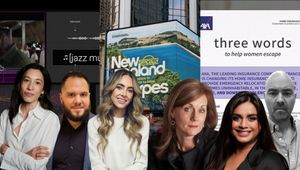
The Secret to Successful OOH with DDB New Zealand

Out of home (OOH) advertising has become the ‘last skippable ad’, according to many professionals within the business.
It's a sneaky type of advertising. Once you see one billboard, you then see the bus shelters, the train coverings and the pillars in the middle of shopping centres. OOH advertising begs for audiences to pay attention and when it’s successful, becomes a part of our art and culture.
Rosie the Riveter has become an icon used to decorate bedrooms, inform political essays, and has been turned into a meme or two. It’s similar to the way in which Coca-cola’s infamous posters heavily informed the image of the jolly, red coat-wearing, Santa Claus.
DDB New Zealand took home multiple wins for their OOH work with McDonald’s and Samsung during Cannes Lions 2024. As a result, LBB’s Casey Martin sat down with DDB Group's chief creative officer, Matty Burton, to discuss the secret behind successful OOH advertising.

LBB> What makes OOH marketing successful? What is the secret behind OOH?
Matty> OOH gives you a big stature communal medium to play with. Which makes it pretty rare in today’s world. It means that when you see it, you know other people have seen it too, potentially unlike certain digital channels which are increasingly individually personalised and targeted. It’s generally more meaningful knowing that other people have seen the exact same creative as you. We’re social animals after all.
It also requires a bit of cognitive processing. The best OOH invites the audience to join the dots together themselves - which tends to make your message stickier and more memorable. And then from a competitive standpoint, it was a chance for Samsung to play where our competitors are, given that this was a challenger campaign. Because our biggest competitor typically uses OOH as a key, high impact channel for their flagship device launches, this was a good way to have a pop at them in their own backyard.
LBB> Social media marketing means you have to grab an audience's attention within the first five seconds, would you argue that OOH needs to grab the attention of the viewer quicker because of its outdoor nature?
Matty> Every form of advertising needs to grab attention quickly! Obviously in mediums like print and cinema you have a bit more leeway to build out a story, but we work in the business of attention. The power of OOH is in big, visually driven ideas that stand out and cut through against the backdrop of the real world. And that includes other advertising. In social media there’s different techniques you can employ to capture people’s attention e.g. video, visual or sound cues to get the viewer to stay for a bit longer before they keep scrolling. In OOH the challenge is sometimes more difficult as it’s seen from a distance, meaning those big, visually led, interesting, highly crafted ideas get their chance to shine.

LBB> When creating OOH, what challenges often arise?
Matty> People sometimes discount OOH as a one-way medium but increasingly it is also another kind of social. The most interesting and attention grabbing OOH tends to get picked up and shared on socials as much as, if not more so, than anything else. You saw this with Uncommon’s British Airways campaign doing the rounds on LinkedIn a while back. Nike does this to great effect too. OOH gives a big idea stature and legitimacy because of its physical nature.
The other challenge is avoiding trying to overload OOH with loads of competing messages!
Research tells us the more you try to cram in, the lower likelihood any of them will be retained. It’s important to treat OOH in the right way to use its strength to the fullest, which can mean brutal simplicity. We are grateful that our Samsung NZ clients are brave and believe in the strength of a simple, effective idea and execution.
LBB> How important is it for a brand to consider OOH from the very beginning of the decision making process? What advice would you give brands?
Matty> I’d recommend thinking about outdoor early in the creative process alongside engaging with your media partner throughout the process, ensuring the creative idea and media placement work in harmony together. Some of the best OOH examples are either contextually relevant or built for their medium, don’t feel the need for matching luggage or a copy and paste job that would work better elsewhere.

LBB> Samsung’s 'Different' is an incredible piece of OOH and yet so simple at the same time. Talk us through the process of creating these award-winning billboards!
Matty> While the artwork was technically challenging to create (3D model creation and visualisation), we were very aligned from the get go that this had to be visually striking, clean and really let the form factor of the device do the heavy lifting of the idea. Trusting the intelligence of our audience to connect the dots. For Samsung ‘Different’, the insight was playing to the irony that a brand that built itself of being different was making everyone all the same. It’s always much easier to find reasons to say no to an idea like this than say yes. Our amazing Samsung NZ team believed in this from day one, so hats off to them.















